In early 2010 we bought a single Purr…fect fence unit. If you don’t remember, I wrote about my experience installing it. Well, we decided it would be a good idea to expand the fence by ordering another single unit. It was a lot more work than I anticipated, I ran into a few problems that required some ingenuity but in the end it was well worth it. The cats are much happier with the added space and we feel much more comfortable. Here are the details of the upgrade.
Learn from my mistakes!
Here are some “before” pictures…
This turned out to be about a 40′ x 28′ area for the cats, we wanted to make it larger so they could see around the house and be able to run more. We ordered a single unit while they were having a sale that included a free gate.
Step 1.
I needed to take down the old fence and preserve it to my best ability (I was planning on using it again). This was going really well at first, until I go to the post sleeves. It was an especially dry time of the year when I was trying to pull these out of the ground. I was able to get a few of them out, but it became almost impossible for me to remove them (without digging them out. I tried everything and some of the posts sleeves just wouldn’t come out.
This left me in a bit of a predicament. I had already taken down the fence and didn’t have enough post sleeves to put it back up. So, I took one of the post sleeves to Lowe’s to see what I could find. As it turns out the post sleeves are pretty much the same material as aluminum conduit pipe. I bought some aluminum blades for my jigsaw and two 12′ conduit pipes (I believe they were 2 1/4″ width).
I got home, measured the actual post sleeves and started cutting the pipe to length. I needed to make the point at the end of the sleeve (to help drive it into the ground). So I took my 8 lbs. Maul and hit the end of the new sleeves until they were as pointed as possible. They weren’t pretty, but they’d do the job. I ended up burning out the motor on my crappy little Black & Decker jig saw. I ended up cutting about 6 new sleeves to replace the ones buried in the ground.
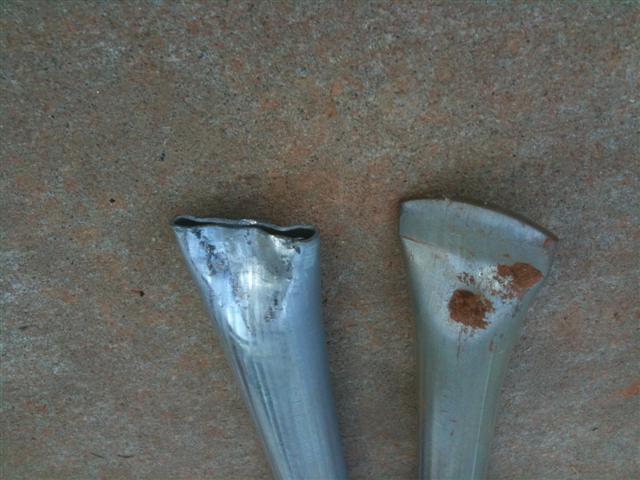
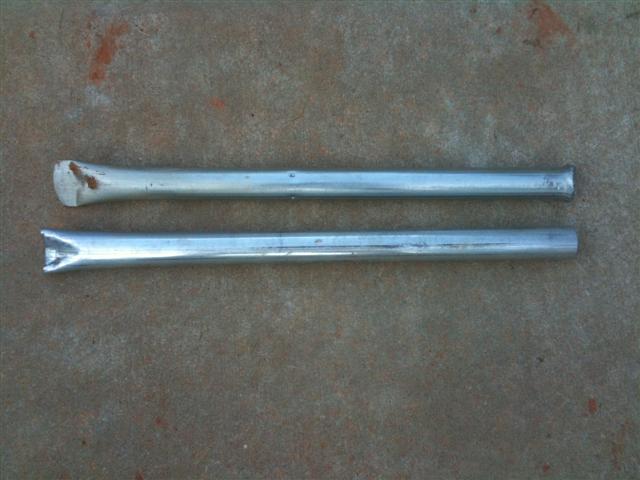

Step 2.
Time to put up the new fence! Again, easier said than done. Remember that dry time of year I told you about? Well, the dry Georgia clay just got harder and dryer about 1 foot into the ground. I destroyed some of the post sleeves trying to smash them into the ground.
It was A LOT harder getting those things into the ground than it was with my first installation. NEVER EVER install one of these things during the dry season in Georgia! As much as I love this fence, it will make you cry. Luckily I had a few extra post sleeves (that I made myself) and was eventually able to get all the sleeves into the ground.
Here are some pictures of the homemade post sleeves and some of the damage done to the sleeves from trying to hit them into the ground.
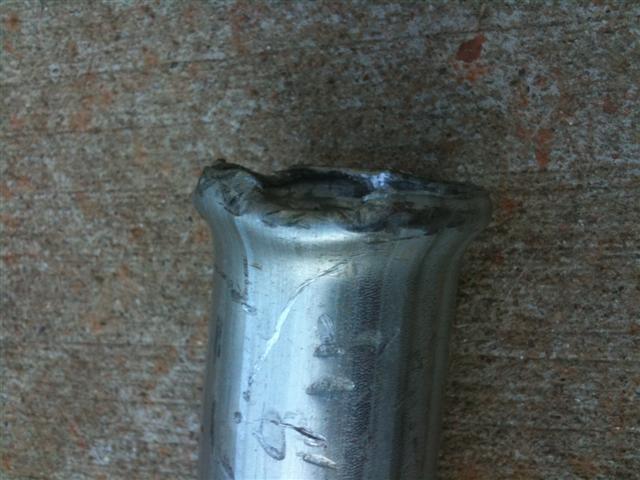

Step 3.
Next I had to install the poles. This was pretty straight forward. The only extra bit I had to worry about was with my new homemade post sleeves. The Purrfect Fence sleeves have little dimples that hold the poles above the bottom of the sleeve (about 8 inches). In order to make the poles even in height, I had to make sure I drilled the poles into the sleeves at the right height. This was easiest with two people, I had my wife hold the pole and I used a tape measure to put it in the proper height. Then I drilled the pole into the sleeve (which is part of the installation process anyway). This way all the poles in the home made sleeves were the same height as the regular sleeves.
Step 4.
Once I got all the sleeves and poles in, the rest was pretty much exactly like the original installation process. The only difference was that I had a large slope on one side of the house (which is explained in the DVDs that come with the fence). I also had to make sure I had enough fence to cover the area (since my old fence was cut in some spots). I tried to lean towards having a little too much and ended up with the perfect amount left over. I had a spot in between two posts that I had to zip tie together. It is not a big deal and it is hardly noticeable. I basically worked around from one side of the house until I got to the end of the fencing, then the other side of the house. Once the fencing was installed on the poles, nice and taught, I zip tied the two separate fences together. I tried to make them as tight as possible without causing any extra bowing.
I also have a hill in the backyard to content with, so I needed to angle the outside corners of the fence. This wasn’t a huge problem, it’s just like a normal 90 degree corner (just a little easier).
Step 5.
After you’ve installed the fencing material and put down the chew guard, you have to do the dreaded stakes. By the way, the chew guard that came with this fence was a little different than the chew guard I had with the old fence. This was a little more malleable and seemed like a smaller gauge. I did ended up pinching a nerve in my hand trying to push down the chew guard with my fist. Just happened to pinch right between my pinky and ring finger nuckles and BAM a throbbing pain in my hand. It hurt for a couple weeks, kind of a numb feeling. I almost went to the doctor, but eventually it worked itself out.
So, the staking… oh how I hate the staking. Staking is even worse when you are already dealing with dry ground and have spent too many hours bashing in 3′ sleeves. Now I had to deal with these stakes! It was even more miserable than it was last time. I wish there was a stake gun! I spaced the stakes out a little more than I did last time. Everything seems to have held up so far. It took me as long as I expected, but it was still too long to be happy about it.
Step 6.
Now that everything is staked in and my arms are gel, it’s time to zip tie the guard to the fencing. This was not so bad, last time I zip tied about ever 2″, this time I did it every 3″-4″ (which is what they recommend). I also discovered a better method for zip tying. Previously, I would pull the fencing and try to force the fence bottom to be “straight”. I realized that this was actually causing extra bowing in the fence because of how the fencing naturally forms to the fence poles and level of the ground. So, instead of trying to force the fence “line” to be straight, I just zip tied every 3″-4″ where the fence naturally met with the chew guard. The fence has a lot less bowing in it now and looks much nicer.
And then the fence is done! Well, almost…
Step 7.
One of the reasons we bought the additional fence was because it came with a free gate! I didn’t install it until a few weekends after installing the fence, but it was very simple to add. Their instructions are pretty straight forward. Just zip tie the whole thing onto the fence and then cut between the lines.
Here are some “after” pics… I actually just took these last weekend, so the grass and back hill might look a bit different :).
It has been several months since I actually upgraded the fence and I have to say the cats LOVE the extra room… we all do. The fence is a lot less noticeable, we have more room to do stuff with them and we were even able to add a swing to the back yard (as you can see). The cats also get to see around the house, although, if there is anything good to look at, they usually freak out and run back inside. They’ve even brought in a couple mice for mommy!
So my advice, install the fence when you know the ground is soft, otherwise you are going to be in some serious pain. But even if you have to do it in the middle of a drought, it’s worth it.
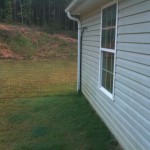
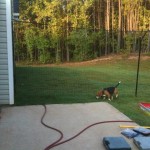
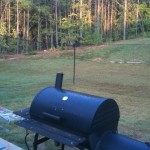

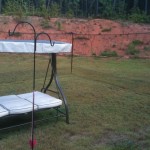

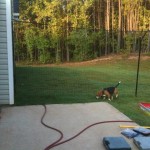

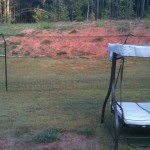
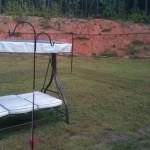
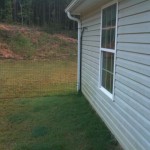
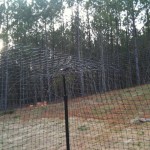
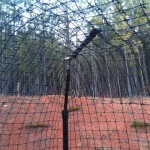
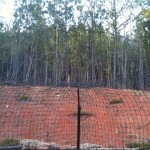
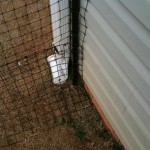


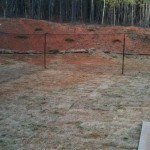
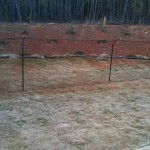


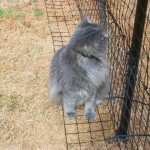
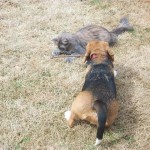


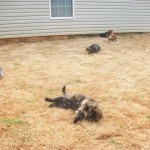

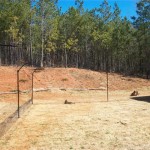

Wow! You sure do have dry soil judging from your pics. Thank you for posting your experience. I’m sure this will be a help to me when I install my system next spring.
We owe you for sharing your first hand experience. I lost the installation CD in a house robbery….so your posts were the best thing in the world to helping us do it right. thank you thank you. We just installed everything but the chew fence….tomorrow we’ll finish up – thanks to you. Merry Christmas.
Glad to help :)